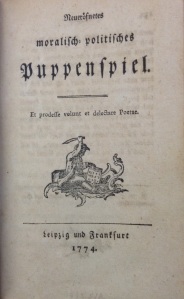 The Skizzenbuch, a delightful early work by Franz Kugler (1808-1858), has recently been added to the University Library’s collections (8002.c.43). Franz Kugler is mainly known for his contributions to art history. His main work the Handbuch der Kunstgeschichte (Acton.c.50.506), first published in 1842, is one of the earliest art survey texts with a global perspective. Kugler was a key figure in the development of art history as an academic discipline, and one of the first persons to hold a chair in art history at a university.
The Skizzenbuch, a delightful early work by Franz Kugler (1808-1858), has recently been added to the University Library’s collections (8002.c.43). Franz Kugler is mainly known for his contributions to art history. His main work the Handbuch der Kunstgeschichte (Acton.c.50.506), first published in 1842, is one of the earliest art survey texts with a global perspective. Kugler was a key figure in the development of art history as an academic discipline, and one of the first persons to hold a chair in art history at a university.
The Skizzenbuch however, published in 1830 by G. Reimer in Berlin when Kugler was only twenty-two, demonstrates his talents as a poet, composer and artist.
 In the Skizzenbuch Kugler published a collection of his poems, a few of which he set to music; one ‘Rudelsburg: an der Saale hellem Strande …’ became a popular song. In the Skizzenbuch this poem is accompanied by an engraving by Kugler’s artist friend Robert Reinick. Kugler’s poems are mainly observations on his travels, recalling people and landscapes he had encountered. Some describe paintings he encountered, some are addressed to fellow artists such as Schinkel or members of the young artists’ circle in Berlin, others deal with architecture and buildings. There is also a drinking song for students. Kugler also set to music poems by Ludwig Uhland, Heinrich Heine, Clemens Brentano, Wilhelm Wackernagel and the dedicatee Adelbert von Chamisso. Continue reading “The Skizzenbuch”
In the Skizzenbuch Kugler published a collection of his poems, a few of which he set to music; one ‘Rudelsburg: an der Saale hellem Strande …’ became a popular song. In the Skizzenbuch this poem is accompanied by an engraving by Kugler’s artist friend Robert Reinick. Kugler’s poems are mainly observations on his travels, recalling people and landscapes he had encountered. Some describe paintings he encountered, some are addressed to fellow artists such as Schinkel or members of the young artists’ circle in Berlin, others deal with architecture and buildings. There is also a drinking song for students. Kugler also set to music poems by Ludwig Uhland, Heinrich Heine, Clemens Brentano, Wilhelm Wackernagel and the dedicatee Adelbert von Chamisso. Continue reading “The Skizzenbuch”








